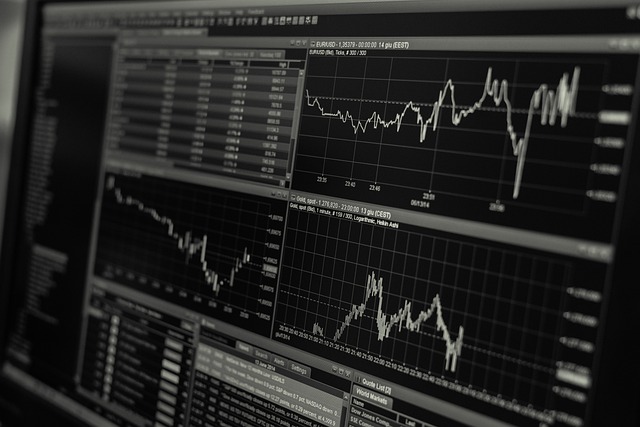Risks of Futures Trading in 2025: Essential Guide
Author: Jameson Richman Expert
Published On: 2025-10-31
Prepared by Jameson Richman and our team of experts with over a decade of experience in cryptocurrency and digital asset analysis. Learn more about us.
Futures trading can deliver powerful returns, but understanding the risks of futures trading is essential before you commit capital. This guide explains the primary risks — from leverage and margin calls to liquidity and counterparty exposure — and provides practical risk-management techniques, examples, and up-to-date tools for traders in 2025. Whether you’re trading commodity, crypto, or financial futures, you’ll find actionable strategies, high-authority references, and links to platforms and automation resources to help you trade more safely and intelligently.

Why futures trading attracts traders — and why it’s risky
Futures contracts let traders buy or sell an asset at a predetermined price at a future date. They’re used for speculative gains, hedging, and price discovery. The appeal of futures lies in leverage, liquidity (in many markets), and the ability to go long or short with relative ease. However, these same traits create elevated risk: amplified losses, rapid liquidations, and complex margin dynamics.
For a technical overview of what futures are, see the Wikipedia entry on futures contracts: Futures contract — Wikipedia.
Core risks of futures trading (overview)
- Leverage and magnified losses
- Margin calls and forced liquidation
- Market volatility and gap risk
- Liquidity risk
- Counterparty and exchange risk
- Basis and convergence risk
- Operational and technology risk
- Regulatory and legal risk
- Emotional and behavioural risk
1. Leverage and magnified losses
Leverage in futures lets you control a large notional position with a relatively small margin deposit. While this increases potential profits, it equally magnifies losses.
Example: How leverage multiplies losses
Imagine you open a futures position with 10x leverage on a notional $100,000 contract by posting $10,000 margin. A 10% adverse move in the contract price would produce a $10,000 loss — the entirety of your margin — whereas an unleveraged investor would lose only $10,000 out of $100,000 (10%). Smaller adverse moves can quickly erase margin with higher leverage.
Key mitigation: apply conservative position-sizing (e.g., risking 1%–2% of account per trade), avoid maximum allowed leverage, and use pre-defined stop-loss orders.

2. Margin calls and forced liquidation
Margin requirements can change intraday. If your account equity falls below maintenance margin, exchanges or brokers will issue a margin call. Failure to top up results in forced liquidation of positions — often at disadvantageous prices — crystallizing losses.
- Understand initial vs. maintenance margin levels for your instrument.
- Keep cash buffer or collateral to meet volatility-driven margin increases.
- Use exchange-provided simulators or risk calculators to estimate potential margin calls during stress scenarios.
3. Market volatility and gap risk
Rapid price swings and gaps between sessions (e.g., overnight for some assets) can produce losses beyond stop orders. Crypto futures may trade 24/7 with extreme volatility, while commodity and equity index futures can gap after news events.
Example: A stop-loss placed at $50 may not execute at $50 if the market gaps to $40; the execution occurs at the next available market price.
Mitigation: use position sizing that accommodates volatility, consider guaranteed stop-loss products when available, and avoid holding highly leveraged positions through major scheduled events like key economic releases or earnings reports.
4. Liquidity risk
Illiquid futures contracts can have wide bid-ask spreads and insufficient depth, meaning large orders move the market and can incur significant slippage. Less-traded contract months or certain commodity contracts have this problem.
To check liquidity, look at open interest and average daily volume (ADV) and prefer front-month contracts with tight spreads.

5. Counterparty and exchange risk
Trading via centralized exchanges introduces counterparty risk (whether the exchange honors positions and withdrawals). For regulated futures traded on exchanges like CME, clearinghouses reduce counterparty risk. For crypto derivatives, exchange solvency and withdrawal restrictions are concerns.
Review exchange transparency, proof-of-reserves, regulatory status, and insurance mechanisms. For crypto-trading platforms, consider registered and highly capitalized exchanges; some centralized exchanges publish proof-of-reserves, which is one indicator (but not a guarantee).
Example exchange links (registration/referral links for convenience):
For regulated U.S. futures and options markets, consult the Commodity Futures Trading Commission (CFTC) to understand protections and rules: CFTC — official site.
6. Basis and convergence risk
Basis is the difference between the futures price and the underlying spot price. When you use futures for hedging, imperfect convergence between futures and spot at contract expiry (or rolling costs when extending exposure) creates basis risk. This is especially relevant for commodities and crypto futures that have funding rates or calendar spreads.
Hedgers need to model historical basis volatility and incorporate roll yields and funding costs into hedging strategies.
7. Operational and technology risk
System outages, connectivity issues, software bugs, or incorrect automated rules can produce devastating results when trading leveraged futures. Many traders now use algorithmic execution and trading bots — which provides efficiency but adds operational risk.
Resources for safer automation:
- Use robust APIs and rate-limit handling. See an in-depth guide on using TradingView API for automation and safer signal integration: How to use TradingView API effectively in 2025.
- Backtest strategies extensively on historical data, including out-of-sample periods.
- Implement kill-switches and multi-layer monitoring to stop-loss bad trades in case of anomalies.

8. Regulatory and legal risk
Regulatory changes can abruptly alter trading conditions (e.g., bans, restrictions, margin rule changes, client asset protections). In crypto derivatives, jurisdictions differ in how they regulate perpetual swaps vs. regulated futures. Keep up with official regulatory announcements and ensure you’re compliant with tax and reporting obligations.
Check local securities and commodities authorities for guidance and updates: in the U.S., the SEC and CFTC provide notices relevant to derivatives markets.
9. Emotional and behavioral risks
Fear, greed, and overconfidence lead traders to increase position sizes, remove stops, or enter revenge trades. Futures amplify these biases because both profits and losses accelerate. Traders must have pre-defined rules and discipline to avoid psychological traps.
Practical tips: use a trading journal, set clear rules for entries/exits, enforce max daily loss limits, and periodically review performance objectively.
Specific risks in crypto futures markets (2025 outlook)
Crypto derivatives have matured but still carry unique risks:
- Funding-rate mechanics on perpetual swaps can create ongoing costs for long or short positions.
- Exchange solvency and withdrawal freezes — verify proof-of-reserves and insurance.
- Smart-contract risk for decentralized derivatives or cross-chain products.
- Regulatory crackdowns or restrictions on retail access in some jurisdictions.
For insights on market trends and trade volume dynamics in specific regions, consider market reports like the 2025 trends forecast covering Mexico and other emerging markets: Trade volume with Mexico — Trends Forecast 2025.

Automation and bots: benefit and hazard
Trading bots can execute strategies without emotion and capture 24/7 opportunities — but they can rapidly compound losses when misconfigured. Use bots only when you understand the logic and failure modes.
If you’re exploring bots, a common approach is to start with well-audited, open-source frameworks or reputable vendors. For guidance on trading bots and automated strategies, see resources like the Binance-related guides and reputable community reviews. A downloadable guide to a Binance trading bot may help you get started with safe testing: Binance trading bot free download — 2025 guide.
Concrete risk-management strategies
Managing the risks of futures trading requires both proactive controls and reactive planning. Below are practical, actionable steps you can implement today.
Risk control checklist
- Position sizing rules: risk a fixed percentage of account equity per trade (commonly 0.5%–2%).
- Leverage caps: set personal leverage limits well below exchange maximums.
- Stop-loss discipline: use stop-loss orders and define contingency plans for slippage and gaps.
- Margin buffer: keep extra cash or low-volatility collateral to absorb margin spikes.
- Diversification: avoid concentration in one instrument, sector, or correlated set of futures.
- Hedging: use offsetting positions or options to limit downside for large exposures.
- Backtesting and stress testing: perform scenario analysis including historical crashes.
- Automation safeguards: include circuit-breakers, position limits, and monitoring alerts.
- Exchange due diligence: choose reputable, well-capitalized exchanges and understand their rules.
- Regulatory compliance and tax planning: keep records and consult tax professionals if needed.
Example: Risk-sizing a futures trade
Account equity = $50,000. Maximum risk per trade = 1% = $500. You trade a futures contract where each tick equals $10. If your stop-loss is 10 ticks away, the per-contract risk = 10 ticks * $10 = $100. Contracts to buy = floor($500 / $100) = 5 contracts. This simple calculation ensures consistent risk exposure regardless of leverage.
Tools and resources for safer futures trading
Use a combination of educational, analytical, and execution tools:
- Price and charting platforms: TradingView, exchange-native charts.
- APIs and automation: TradingView API, exchange REST/WebSocket APIs. (See the comprehensive TradingView API guide above for integration techniques: TradingView API guide.)
- Risk calculators: margin calculators provided by exchanges, or independent sheets that stress-test worst-case drawdowns.
- Data sources: official exchange data, historical tick data vendors.
- Educational resources: Investopedia’s guides (e.g., futures basics) and official exchange documentation.
For algorithmic traders, always sandbox strategies against historical data and run in paper-trading mode before going live. Consider third-party platforms that offer simulated trading accounts to stress test automation under realistic conditions.

Choosing the right exchange — what to check
When deciding where to trade futures, evaluate each exchange on these criteria:
- Regulatory status: Is the exchange regulated or compliant with major jurisdictions?
- Clearinghouse protections: For listed futures, is there a clearinghouse that reduces counterparty risk?
- Liquidity and spreads: Front-month contracts should show high volume and tight bid-ask spreads.
- Margin mechanics and fees: Understand initial/maintenance margin, funding rates, and fee schedules.
- Security and custody: Exchange custody practices, audits, proof-of-reserves, and cold storage for crypto exchanges.
- API quality and support: Good API docs, rate limits, and sandbox environments support automation safely.
If you’re ready to open accounts and evaluate exchanges, here are sign-up links for commonly used global platforms (useful for testing and diversifying counterparty exposure):
- Binance account registration
- MEXC account registration
- Bitget account registration
- Bybit account registration
Case studies: losses and lessons
Case study 1: Leverage-induced wipeout
A futures trader used 50x leverage on a crypto perpetual contract during a volatile session. A sudden 3% adverse move triggered liquidation. The trader lost nearly all the margin and incurred additional fees due to slippage. Lesson: high leverage removes margin for error; limit leverage and use smaller position sizes on volatile instruments.
Case study 2: Bot misconfiguration
An automated strategy meant to short a slow-moving spread was misconfigured and opened a large directional short on the front month. During a scheduled supply shock, the short moved strongly against the bot and executed without human intervention, leading to severe drawdown. Lesson: include manual overrides, pre-launch simulations, and multi-layer monitoring for bots.
Case study 3: Exchange outage
During a flash crash, an exchange’s matching engine lagged and many orders failed to execute. Traders with open leveraged positions experienced significant slippage and margin calls that were not processed in time. Lesson: diversify exposure across exchanges when possible and keep funds on multiple platforms to reduce single-exchange dependency.
Hedging strategies to reduce futures risk
Hedging can be an effective way to reduce downside while maintaining upside exposure.
- Options hedges: buy put options to cap downside on long futures positions.
- Calendar spreads: trade nearby vs. distant contract months to capture roll yield and reduce exposure to sudden basis moves.
- Cross-hedges: use correlated instruments (e.g., index futures vs. individual equities) with caution — cross-hedges introduce basis risk.

Tax and recordkeeping considerations
Futures trading often has different tax treatments depending on jurisdiction. Keep meticulous records of trades, P&L, fees, and funding payments. In the U.S., futures trading may be subject to Section 1256 rules (60/40 treatment), but crypto derivatives and jurisdictional variations complicate this; consult a tax professional. For official guidance, refer to your local tax authority or financial regulator.
How to prepare for 2025 market dynamics
By 2025, futures markets—especially in crypto—are expected to see increased institutional participation, evolving product complexity, and shifting regulation. Prepare by:
- Keeping capital allocation conservative and flexible.
- Maintaining updated knowledge of margin policy changes and new product launches.
- Using robust automation frameworks with monitoring and risk controls. For developers and traders building automation, see the TradingView API guide referenced earlier: TradingView API guide — 2025.
- Keeping an eye on regional trade volume shifts and emerging liquidity hubs; for example, market reports on Mexico and regional trade volumes can highlight opportunities and risks: Trade Volume with Mexico — Trends Forecast 2025.
Final checklist before placing a futures trade
- Confirm instrument liquidity and front-month spreads.
- Calculate position size and ensure it fits your risk budget.
- Verify margin requirements and maintain a cash buffer.
- Set stop-loss and take-profit levels with realistic expectations for slippage.
- Ensure automation (if used) has kill-switches and monitoring alerts.
- Confirm exchange solvency indicators and compliance standards.
- Document trade rationale in a journal for post-trade review.

Further reading and authoritative resources
- Futures contracts — Wikipedia: https://en.wikipedia.org/wiki/Futures_contract
- Commodity Futures Trading Commission (CFTC) — official resources and guidance: https://www.cftc.gov/
- SEC — official announcements and investor guidance: https://www.sec.gov/
- TradingView API integration guide: How to use TradingView API effectively in 2025
- Market trends and regional trade analysis: Trade volume with Mexico — Trends Forecast 2025
- Automation and trading bot guidance: Binance trading bot free download — 2025 guide
Conclusion: balance opportunity with discipline
The risks of futures trading are real and multifaceted. Leverage, margin calls, liquidity shortfalls, counterparty exposure, and operational failures can quickly transform opportunity into heavy losses. The solution is not to avoid futures altogether, but to approach them with rigorous risk management: conservative sizing, clear stop-loss rules, due diligence on exchanges, robust automation safeguards, and ongoing education.
If you plan to trade futures in 2025, iterate on your risk-management playbook continuously, simulate strategies under extreme scenarios, and maintain a defensive mindset. With discipline, tools, and proper preparation you can participate in futures markets while limiting the downside risks that have felled many traders.
Disclaimer: This article is for educational purposes only and does not constitute financial or investment advice. Always perform your own research and consult a licensed professional before trading. Review exchange terms and local regulations before opening accounts or trading derivatives.